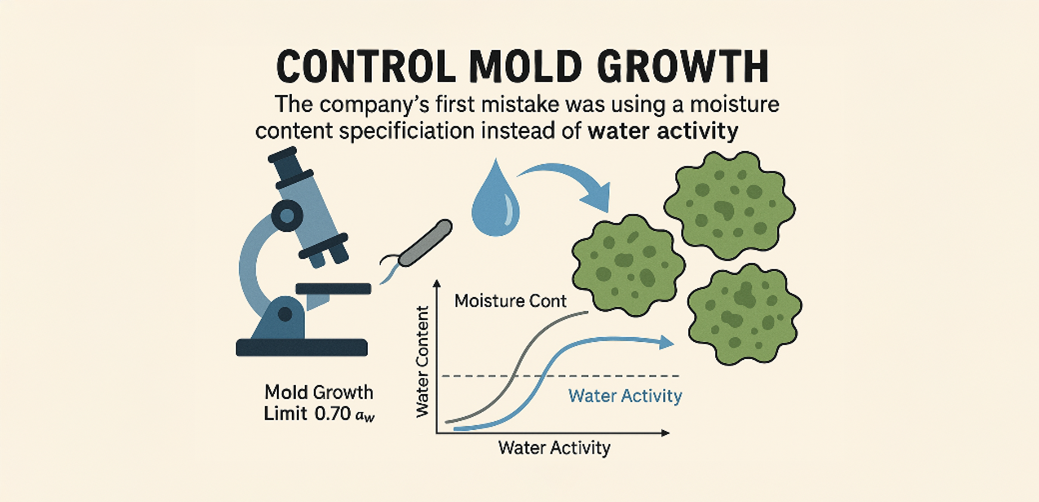Microbial contamination can lead to recalls and financial losses for food manufacturers. Novasina AG emphasizes the key difference between moisture content, which measures water volume, and water activity, which indicates the energy status of water and is crucial for assessing microbial growth
Food manufacturers are responsible for ensuring their products are safe for consumption and do not pose any food safety risks. To achieve this, they must develop a food safety plan that identifies the highest safety risks and outlines critical control mechanisms to allay these risks to acceptable levels. These control mechanisms are represented by specifications that must be met for a product to be released. If these specifications are correctly set and monitored through routine testing, the product should remain safe and profitable. However, if the specifications are not properly monitored or the established specifications are incorrect, there is a risk of product failure, recalls, and serious illness.
Understanding food safety risks
One of the most common risks for intermediate and high-moisture foods is microbial contamination. Pathogenic bacteria can cause foodborne illnesses, while molds can produce mycotoxins and off-flavors. Discovering any type of microbial contamination in a product post-production can lead to mandatory recalls, resulting in wasted product, logistical costs, and reputational damage, which can have long-term financial effects. Therefore, identifying the appropriate critical control mechanisms for microbial contamination and setting the correct release specifications is crucial.
Water activity to control microbial growth
Many companies rely on moisture content as a release specification to ensure product safety. However, moisture content, which measures the amount of water, does not control microbial growth. Instead, water activity, which measures the energy status of water, is the appropriate release specification for controlling microbial growth.
Recently, a major food manufacturer painfully realized the importance of releasing products based on water activity rather than moisture content. For over 20 years, they had produced high-quality products with few complaints. Suddenly, they began receiving multiple complaints about moldy products with potential mycotoxins. How could this happen? They had consistently released products based on the same moisture content specification for 20 years without issues. Despite not changing their moisture content specification, mold appeared unexpectedly. The costs of subsequent recalls, public relations efforts, and causal discovery activities amounted to millions of dollars.
What causes microbial growth in food products?
The company’s first mistake was using a moisture content specification to control mold growth instead of water activity. Each microorganism has an ideal internal water activity, or water energy, which is crucial for their ability to reproduce and grow. (1,2) When a microorganism encounters an environment with lower water activity than its internal water activity, it experiences osmotic stress and begins to lose water to the environment, as water moves from high to low water activity. (1) Microorganisms are not concerned with the amount of water present (moisture content); they only care if the water activity (energy) is high enough for them to access it.
As shown in Table 1, the minimum water activity level needed for growth varies for each microorganism, with the practical limit for mold growth being less than 0.70aw. Any issues with mold growth could have been avoided if the company had used 0.65aw as their release specification instead of moisture content.
Another contributing factor to the sudden appearance of mold was a change in the instrument used to measure moisture content. The new method unknowingly provided lower moisture content readings than the actual moisture content (Figure 1). This discrepancy meant that while the company believed they were adhering to the same moisture content specification, the actual moisture content was three to four percent higher. This increased moisture level corresponded to a water activity higher than the growth limit for mold. If the company had been tracking water activity, they would have immediately noticed the change and realized that the product was being produced with water activities higher than 0.70aw. Implementing a water activity-based release specification would have prevented these issues and saved millions in lost revenue.

Water activity as a solution to mold
The first change implemented was to immediately switch to a water activity release specification below 0.70aw, ensuring that no product failing to meet this specification would be released, regardless of its moisture content. This action promptly eliminated all complaints about mold. The second change was to correct their moisture content measurement to ensure it provided results consistent with historical values. In doing so, they realized that current formulations limit the amount of moisture that can be in their products while still maintaining a safe water activity level. Consequently, the next step was to adjust their formulations to maximize the achievable moisture level while still meeting the newly implemented water activity release specification. This adjustment will allow them to maximize profitability while ensuring that the days of moldy products are behind them.
References
- Beuchat, L. 1983. Influence of water activity on growth, metabolic activities and survival of yeasts and molds. Journal of Food Protection 46(2):135-141.
- Scott, W. 1957. Water relations of food spoilage microorganisms. Advances in Food Research 7:83-127.
- Grant, W. 2004. Life at low water activity. Philosophical Trans of the Royal Soc London 359:1249-1267.


